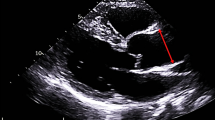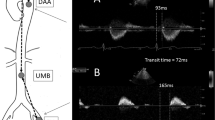Abstract
It is not known whether ascending fractional pulse pressure (PPf) is related to large artery function. This study was to evaluate whether PPf is associated with large artery function by augmentation index. A total of 190 subjects were enrolled (age range: 50 to 78 years) who had normal contractions, no local asynergy, and no history of myocardial infarction. The ascending aortic pressure was measured using a fluid-filled system. To quantify the relative magnitude of the pulsatile to mean artery pressure, we normalised the pulse pressure to the mean pressure and referred to this value as PPf and the association between the PPf and the augmentation index was investigated. Augmentation index showed significant associations with PPf by univariate analysis (R = 0.690, P < 0.001). The associations between PPf and the factors influencing large artery function were examined by multivariate analysis, and PPf revealed significant associations with age, mean aortic pressure, heart rate and type 2 diabetes (R2 = 0.477, P < 0.001). The results were that ascending aortic PPf is closely associated with large artery function detected by augmentation index.
This is a preview of subscription content, access via your institution
Access options
Subscribe to this journal
Receive 12 digital issues and online access to articles
$119.00 per year
only $9.92 per issue
Buy this article
- Purchase on Springer Link
- Instant access to full article PDF
Prices may be subject to local taxes which are calculated during checkout

Similar content being viewed by others
References
Kelly RP et al. Non-invasive determination of age-related changes in the human arterial pulse Circulation 1989 80: 1652–1659
Murgo JP et al. Aortic input impedance in normal man: relationship to pressure wave forms Circulation 1980 62: 105–116
Murgo JP et al. Effects of exercise on aortic input impedance and pressure wave forms in normal humans Circ Res 1981 48: 334–343
Nakayama Y et al. Pulsatility of ascending aortic pressure waveform is a powerful predictor of restenosis after percutaneous transluminal coronary angioplasty Circulation 2000 101: 470–472
Nakayama Y et al. Noninvasive differential diagnosis between chronic pulmonary thromboembolism and primary pulmonary hypertension by means of doppler ultrasound measurement J Am Coll Cardiol 1998 31: 1367–1371
Nakayama Y et al. Characteristics of pulmonary artery pressure waveform for differentially diagnosing chronic pulmonary thromboembolism and primary pulmonary hypertension J Am Coll Cardiol 1997 29: 1311–1316
Nishijima T et al. Pulsatility of ascending aortic pressure waveform is associated with an increased risk of coronary heart disease Am J Hypertens 2001 14: 469–473
Sunagawa K, Maughan WL, Sagawa K . Stroke volume effect of changing arterial input impedance over select-ed frequency ranges Am J Physiol 1985 248: H477–H486
O'Rourke MF . Steady and pulsatile energy losses in the systemic circulation under normal conditions and in simulated arterial disease Cardiovasc Res 1967 1: 313–326
Sunagawa K et al. Impedance loading servo pump system for excised canine ventricle Am J Physiol 1982 243: H346–350
Author information
Authors and Affiliations
Rights and permissions
About this article
Cite this article
Nakayama, Y., Ueda, H., Tsumura, K. et al. Ascending fractional pulse pressure closely relating to large artery function. J Hum Hypertens 16, 243–247 (2002). https://doi.org/10.1038/sj.jhh.1001382
Received:
Revised:
Accepted:
Published:
Issue Date:
DOI: https://doi.org/10.1038/sj.jhh.1001382



